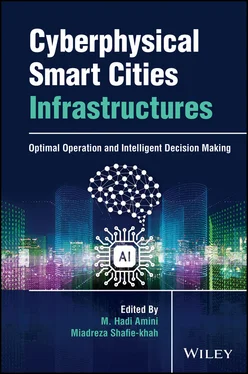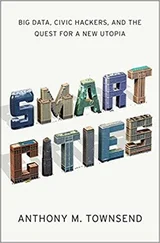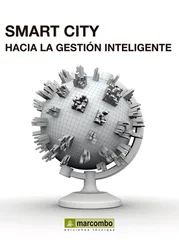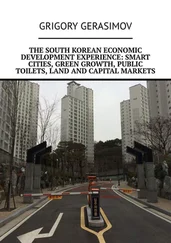Cyberphysical Smart Cities Infrastructures
Здесь есть возможность читать онлайн «Cyberphysical Smart Cities Infrastructures» — ознакомительный отрывок электронной книги совершенно бесплатно, а после прочтения отрывка купить полную версию. В некоторых случаях можно слушать аудио, скачать через торрент в формате fb2 и присутствует краткое содержание. Жанр: unrecognised, на английском языке. Описание произведения, (предисловие) а так же отзывы посетителей доступны на портале библиотеки ЛибКат.
- Название:Cyberphysical Smart Cities Infrastructures
- Автор:
- Жанр:
- Год:неизвестен
- ISBN:нет данных
- Рейтинг книги:4 / 5. Голосов: 1
-
Избранное:Добавить в избранное
- Отзывы:
-
Ваша оценка:
- 80
- 1
- 2
- 3
- 4
- 5
Cyberphysical Smart Cities Infrastructures: краткое содержание, описание и аннотация
Предлагаем к чтению аннотацию, описание, краткое содержание или предисловие (зависит от того, что написал сам автор книги «Cyberphysical Smart Cities Infrastructures»). Если вы не нашли необходимую информацию о книге — напишите в комментариях, мы постараемся отыскать её.
Cyberphysical Smart Cities Infrastructures: Optimal Operation and Intelligent Decision Making,
Cyberphysical Smart Cities Infrastructures
Cyberphysical Smart Cities Infrastructures — читать онлайн ознакомительный отрывок
Ниже представлен текст книги, разбитый по страницам. Система сохранения места последней прочитанной страницы, позволяет с удобством читать онлайн бесплатно книгу «Cyberphysical Smart Cities Infrastructures», без необходимости каждый раз заново искать на чём Вы остановились. Поставьте закладку, и сможете в любой момент перейти на страницу, на которой закончили чтение.
Интервал:
Закладка:
To some degree, it is possible to predict what is coming for AI. This can be achieved by looking at the current trajectory and extrapolating what will be coming next. However, this extrapolation is extremely limited. Deep neural networks as a basic structure for AI existed back in the 1980s; it was not until recently when there was enough data and technological capabilities that this became a reality [4]. Without knowing what technological advances will disrupt the status quo or become available, it is impossible to predict the far future of AI. This is the underlying importance of being viewed as a top innovator and researcher into the subject, so the United States may be first with the latest and greatest AI applications.
1.7 Conclusion
When considering the intersection of AI, cybersecurity, and healthcare industry, we have seen that a myriad of problems exist today, and there are more coming down the pipe in the future. To be prepared, there are several issues that must be addressed. The first issue is also the hardest to resolve, and that is the morality of AI. Morality is a fluid topic that changes not only over time but also by who is viewing the moral issue. Therefore, it is recommended that an international organization preside over AI and what morals are being implemented into AI in the current and future state. By having an international organization, it would allow voices to be heard from all nations so that the best possible options can be decided. The reason that this issue is the hardest to resolve is a conflict between morality and legislation. Having an international organization that acts as a ruling body impedes growth and cannot keep pace with AI in numbers and advancements.
The second issue that must be addressed for a sustainable AI future in healthcare is a lack of cybersecurity within devices. Currently there is an incentive to being the first to market with new products and having those products work, and the focus is on R&D. However, ensuring that these devices are protected from outsider attacks is costly and time consuming and often done after the fact. In a similar way that the federal government provides funding to schools and other research areas, a similar alleviation of cost of security would help ensure that products are secure before reaching the market, not done afterward.
Establishing partnerships between the federal government and academia is a great way to ensure that the future of AI remains bright. These programs that develop and foster the relationship between the two must be increased in size and magnitude, or else the United States risks falling behind other countries and private corporations as the leading developer of AI.
AI is a disruptive technology that will change our lives in one way or another. By addressing issues while the developments of AI are still young, it can be ensured that AI becomes a tool that is constructive rather than being used as a weapon for destruction.
References
1 1 Bryson, J. and Winfield, A. (2017). Standardizing ethical design for artificial intelligence and autonomous systems. Computer 50 (5): 116–119.
2 2 Rigby, M.J. (2019). Ethical dimensions of using artificial intelligence in health care. AMA Journal of Ethics 21 (2): 121–124.
3 3 Hamet, P. and Tremblay, J. (2017). Artificial intelligence in medicine. Metabolism 69: S36–S40.
4 4 Executive Office of the President of the United States (2019). The National Artificial Intelligence Research and Development Strategic Plan: 2019 Update. A Report by the Select Committee on Artificial Intelligence of the National Science and Technology Council.
5 5 Gibian, D. (2019). Hacking AI: Rethinking cybersecurity for Artificial Intelligence. https://www.linkedin.com/pulse/rethinking-cybersecurity-ai-davey-gibian/(accessed 16 July 2021).
6 6 Moisejevs, I. (2019). What Everyone Forgets About Machine Learning. https://calypsoai.com/insights/calypso-newswire/what-everyone-forgets-about-machine-learning/(accessed 16 July 2021).
7 7 Buchanan, B.G. (2005). A (very) brief history of artificial intelligence. Ai Magazine 26 (4): 53–53.
2 Data Analytics for Smart Cities: Challenges and Promises
Ghareh Mohammadi1, Farzan Shenavarmasouleh1, M. Hadi Amini2, and Hamid Reza Arabnia1
1Department of Computer Science, Franklin College of Arts and Sciences, University of Georgia, Athens, Georgia
2Knight Foundation School of Computing and Information Sciences, Florida International University, Miami, FL, USA
2.1 Introduction
 Motivation: The explosion of advancement in artificial intelligence (AI), sensor technologies like Internet of things (IoT), and wireless communication activates ubiquitous sensing through distributed sensors in various domains of networks that lead us to smart systems in healthcare, transportation, environment, and other relevant branches/networks. Having collaborative interaction among the smart systems connects end‐user devices to each other, enabling a new integrated entity called smart cities.
Motivation: The explosion of advancement in artificial intelligence (AI), sensor technologies like Internet of things (IoT), and wireless communication activates ubiquitous sensing through distributed sensors in various domains of networks that lead us to smart systems in healthcare, transportation, environment, and other relevant branches/networks. Having collaborative interaction among the smart systems connects end‐user devices to each other, enabling a new integrated entity called smart cities.
In the last decade, the IoT devices have been connected among different independent agents and heterogeneous networks as with communication technologies [1, 2]. The connected high‐performance sensors and end‐user devices, IoT, are the trigger leveraging the networks in transitioning from urban cities toward smart sustainable cities. The goal of smart cities is to address upcoming challenges of conventional cities by offering integrated management systems with a combination of intelligent infrastructures [3].
Making decisions in smart cities is challenging due to the high direct/indirect dimensional factors and parameters. In this chapter, we aim to focus on one of the smart cities' important branches, namely, smart mobility and its positive ample impact on smart cities' decision‐making processes. Intelligent decision‐making systems in smart mobility offer many advantages, such as saving energy [4], relaying city traffic [5], and more importantly reducing air pollution [6] by offering real‐time useful information and imperative generated knowledge. Making an optimal decision in time in smart mobility with a wide variety of smart devices and systems is challenging. You cannot make a promising decision when your data is not frequently collected. Consequently, a training process of decision support systems still is challenging due to the lack of data [7]. In this chapter, first, we address current challenges in smart cities and provide an overview of potential solutions to these challenges. Then, we offer a framework of these solutions, called universal smart cities' decision making, having three main sections such as data capturing, data analysis, and decision making to optimize the smart mobility within smart cities.
Interestingly, large cities are losing their own urban style and turning into smart ones. Smart cities are growing due to the advanced technology, especially AI. The more people live in large cities, the more need to have an integrated system to cost‐efficiently handle the ample growth in urbanization. The proliferation of population offers smart development challenges in such cities and enables enormous pressure on society to create innovative, smart, and sustainable environments. Therefore, today's developed cities (or smart cities) are in need of integrated smart policies and novel innovative solutions to enhance the monitoring functionality to facilitate urban living conditions [8].
Smart cities are created to enable advanced capabilities, such as sustainable energy systems and electrified transportation networks, and interact with information and communication technologies (ICTs) to enhance the efficiency of the cities being generated [9, 10]. An example of responding to new changes for smart cities may be seen in the progress being made in smart healthcare systems for emergency care cases. For the hospitals to be able to monitor and control their patients and let the specialists offer better solutions to their patients, they need to use a smart healthcare system [11, 12].
Читать дальшеИнтервал:
Закладка:
Похожие книги на «Cyberphysical Smart Cities Infrastructures»
Представляем Вашему вниманию похожие книги на «Cyberphysical Smart Cities Infrastructures» списком для выбора. Мы отобрали схожую по названию и смыслу литературу в надежде предоставить читателям больше вариантов отыскать новые, интересные, ещё непрочитанные произведения.
Обсуждение, отзывы о книге «Cyberphysical Smart Cities Infrastructures» и просто собственные мнения читателей. Оставьте ваши комментарии, напишите, что Вы думаете о произведении, его смысле или главных героях. Укажите что конкретно понравилось, а что нет, и почему Вы так считаете.

![Чарльз Диккенс - A Tale of Two Cities [С англо-русским словарем]](/books/26616/charlz-dikkens-a-tale-of-two-cities-s-anglo-thumb.webp)










